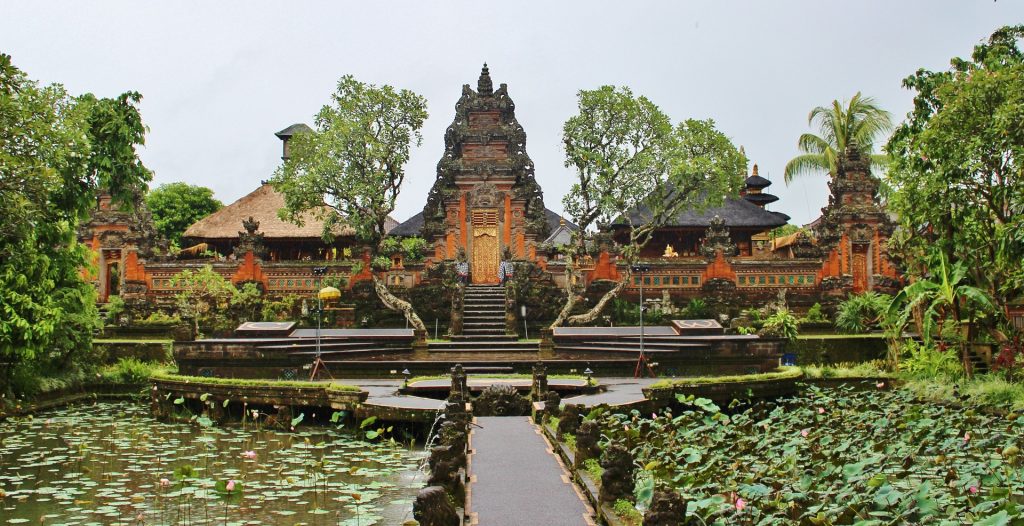Discovering the Cultural Heart of Bali
Ubud Palace aka Puri Saren Agung
Nestled in the vibrant center of Ubud, the Ubud Palace, also known as Puri Saren Agung, stands as a testament to Bali’s rich cultural heritage and royal history. This iconic landmark, which once served as the official residence of Ubud’s royal family, is a must-visit destination for anyone looking to immerse themselves in the artistic and cultural essence of Bali.
The Historical Significance of Ubud Palace
Ubud Palace was built in the early 19th century during the reign of Ida Tjokorda Putu Kandel, and it continues to be a central figure in Ubud’s cultural landscape. The palace’s strategic location at the crossroads of Ubud’s main roads, Jalan Raya Ubud and Jalan Monkey Forest, makes it an easily accessible destination for visitors exploring the area.
The palace is not just a historical relic but also a living part of Ubud’s cultural fabric. It remains the residence of Ubud’s royal family, and its courtyards and buildings are still used for important ceremonies and traditional events. The architecture of the palace is a stunning example of traditional Balinese design, with its ornate carvings, gold-leafed doorways, and meticulous attention to detail reflecting the island’s artistic heritage.
What to See and Do at Ubud Palace
- Explore the Royal Courtyards: Visitors are welcome to explore the beautifully maintained courtyards of Ubud Palace. The intricate stone carvings, traditional pavilions, and lush gardens provide a peaceful retreat from the bustling streets of Ubud. Each corner of the palace offers a glimpse into the grandeur of Bali’s royal past.
- Admire Traditional Balinese Architecture: The Ubud Palace is an excellent place to appreciate the unique architecture of Bali. The palace structures feature elaborately carved wooden doors, stone carvings, and statues that depict scenes from Balinese mythology and folklore. The attention to detail in every element of the palace is a testament to the skilled artisans of Ubud.
- Experience a Traditional Balinese Dance Performance: One of the highlights of visiting Ubud Palace is the opportunity to witness traditional Balinese dance performances, which are held in the evenings. These performances take place in the palace’s open-air courtyard, providing an authentic cultural experience against the backdrop of the historic palace. The dances, such as the Legong and Barong, are accompanied by traditional gamelan music, offering a mesmerizing display of Balinese artistry.
- Learn About Balinese Royalty: Although the palace is still home to Ubud’s royal family, parts of it are open to the public, allowing visitors to learn about the history and significance of the royal family in Bali’s culture. Guided tours are available to provide deeper insights into the palace’s history and the role of the royal family in the development of Ubud as a cultural center.
- Photographic Opportunities: The grandeur of Ubud Palace makes it a popular spot for photography. From the intricate details of the carvings to the expansive courtyards, every angle of the palace offers a picture-perfect moment. The golden light of early morning or late afternoon adds a magical quality to the already stunning surroundings.
Tips for Visiting Ubud Palace
- Best Time to Visit: The palace is open to visitors throughout the day, but it’s best to visit in the early morning or late afternoon to avoid the midday heat and crowds. Evening visits are also recommended if you plan to watch a traditional dance performance.
- Respect the Sacredness: While exploring the palace, remember that it is not just a tourist attraction but also a sacred site and the home of the royal family. Dress modestly and be respectful of the customs and traditions observed within the palace grounds.
- Explore Nearby Attractions: Ubud Palace is centrally located, making it easy to explore nearby attractions such as the Ubud Art Market, Saraswati Temple, and the Campuhan Ridge Walk. These can all be combined into a day of cultural exploration in Ubud.
Ubud Palace is more than just a historic site; it is a living symbol of Bali’s rich cultural heritage and artistic traditions. Whether you are exploring the palace’s beautiful courtyards, admiring its traditional architecture, or experiencing a mesmerizing Balinese dance performance, a visit to Ubud Palace offers a unique insight into the heart of Bali. Make sure to include this cultural gem in your Ubud itinerary to fully appreciate the island’s royal and artistic legacy.
